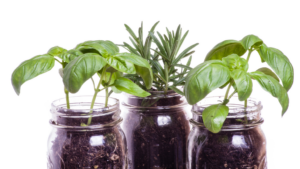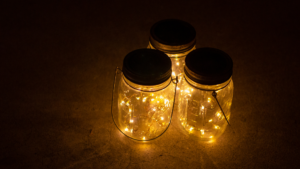You probably already have a bunch of used glass bottles or jars around the house – and if you don’t see yourself taking a trip to the bottle bank any time soon, why not unleash your green fingers and repurpose it?
As the seasons turn and we start heading back indoors, we’ve put together a list of our top recommendations for easy garden upcycling:
Windowsill herbs
Ever tried out a new recipe and discovered last-minute that you don’t the right herbs in the fridge? Be ready for anything, with handy herbs potted in glass jars. No need for a garden – they’ll fit right on your kitchen windowsill, and nothing beats cooking with fresh herbs you grew yourself!
For best results, clean out a jar, line the base with some small stones, then sprinkle some horticultural charcoal on top before adding soil and planting the herb. The charcoal absorbs any excess water, and guards against bacteria, fungus and rot.
If you’re feeling extra creative, why not go one step further and create a mounted herb garden:
If you’re not the cooking type, try planting non-edible plants in glass for your windowsill instead. Nothing is cuter than baby spider plants and cacti in mini jam jars, if you ask us.

Homemade terrarium
Design your own mini-climate by filling a glass container with rocks, charcoal, soil and plants. Choose similar plants: either cacti/succulents (very little water needed, best left open to the air) or ferns/ivies/begonias (water-lovers, happy with the lid on), as well as any decorative pieces you want, like pebbles, moss or shells. Glass is perfect for terrariums because it works like a greenhouse when exposed to sunlight, heating up its contents to the perfect temperature, and acts as a natural barrier to any contaminants that could harm your plants.
Fun fact: The first terrarium was created by mistake by Nathaniel Bagshaw Ward in 1842 when a fern started growing in a jar he was using to observe insect behaviour. Since then, many people have created their own (intentional) terrariums: the longest surviving one is 60 years old and has only been opened once in its entire life!
DIY bottle lighting
Give your garden a real glow-up with some homemade patio lights. Fill a glass bottle with fairy lights, glue twine around the neck of the bottle and suspend it for a hanging outdoor lamp. If you’re feeling more hands-on, you could try glass cutting to remove the base of the bottle.
You’ll need something sharp to score the bottle where you want to cut it, as well as enough string to wrap around this line a few times. Before tying it to the bottle, soak the string in acetone or nail polish remover. Prepare a bucket of very cold water, then light the string on fire (be careful not to burn yourself!). Turn the bottle to make sure the string burns evenly, then once it’s burnt out, plunge it gently into the water. The glass should split along the line you marked. Make sure to carefully sand the glass edges with sandpaper right away as it’ll be very sharp.
You can use either section of the bottle as a candle cover for a table light. The glass will protect the candle from the wind and add ambiance to your outdoor space ✨
Want to jazz up your new bottle lights? If you’re using clear glass bottles, paint them. Turn on the fairy lights or light the candle inside to see design glow!
Bottle plant waterers
Never accidentally kill your plant by forgetting to water it again! Repurpose your used glass bottles to make chic plant waterers that keep your plants hydrated by feeding them whenever they need it.
Make sure to clean out the bottle first! Then, you’ll need to adapt the bottle stop. Using a screwdriver or corkscrew, make a hole going all the way through your bottle cap or cork. (If you’ve lost it, cut out a circle of cotton fabric to cover the opening, and attach it with an elastic band). This makes sure that the water comes out slowly and doesn’t flood your plant.
Next, fill your glass bottle with water (and plant food, if needed) and reattach the lid/cork/cover. Make sure the soil is damp and dig a hole about 5cm deep. Invert the bottle and press it into the hole until it won’t go any deeper (be careful that the glass doesn’t break). Voilà! Your very own plant waterer. Don’t forget to fill it up again once the bottle is empty!
Choose green glass bottles to blend in with the foliage, or try decorating your clear bottles to make them stand out.
Fun fact: 80-95% of a plant is made up of water. Plants need water for photosynthesis, but if they get dehydrated they don’t grow well, they’re more susceptible to disease and insects and they’ll wilt. Just like us, plants need to be watered properly to thrive.





